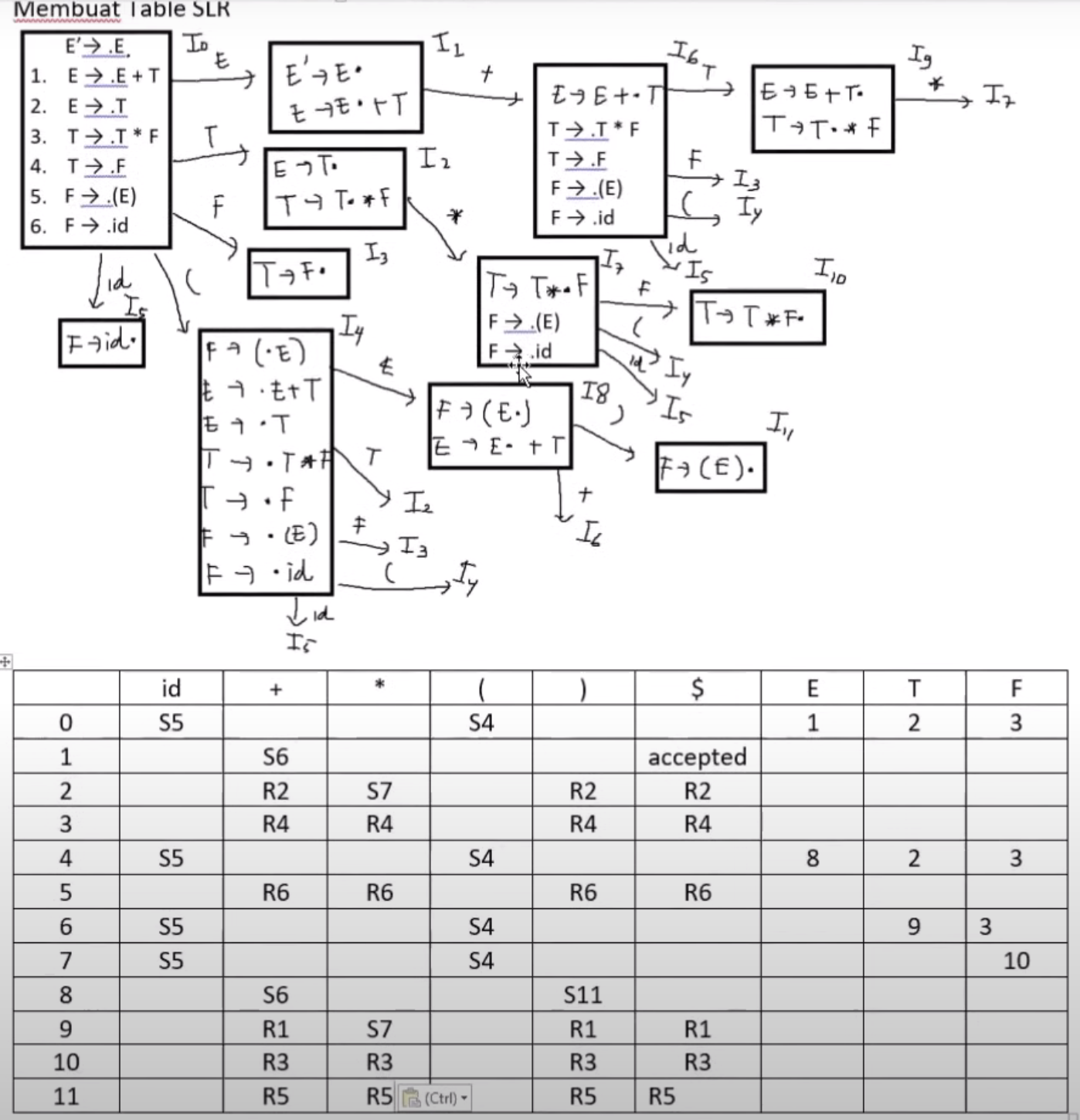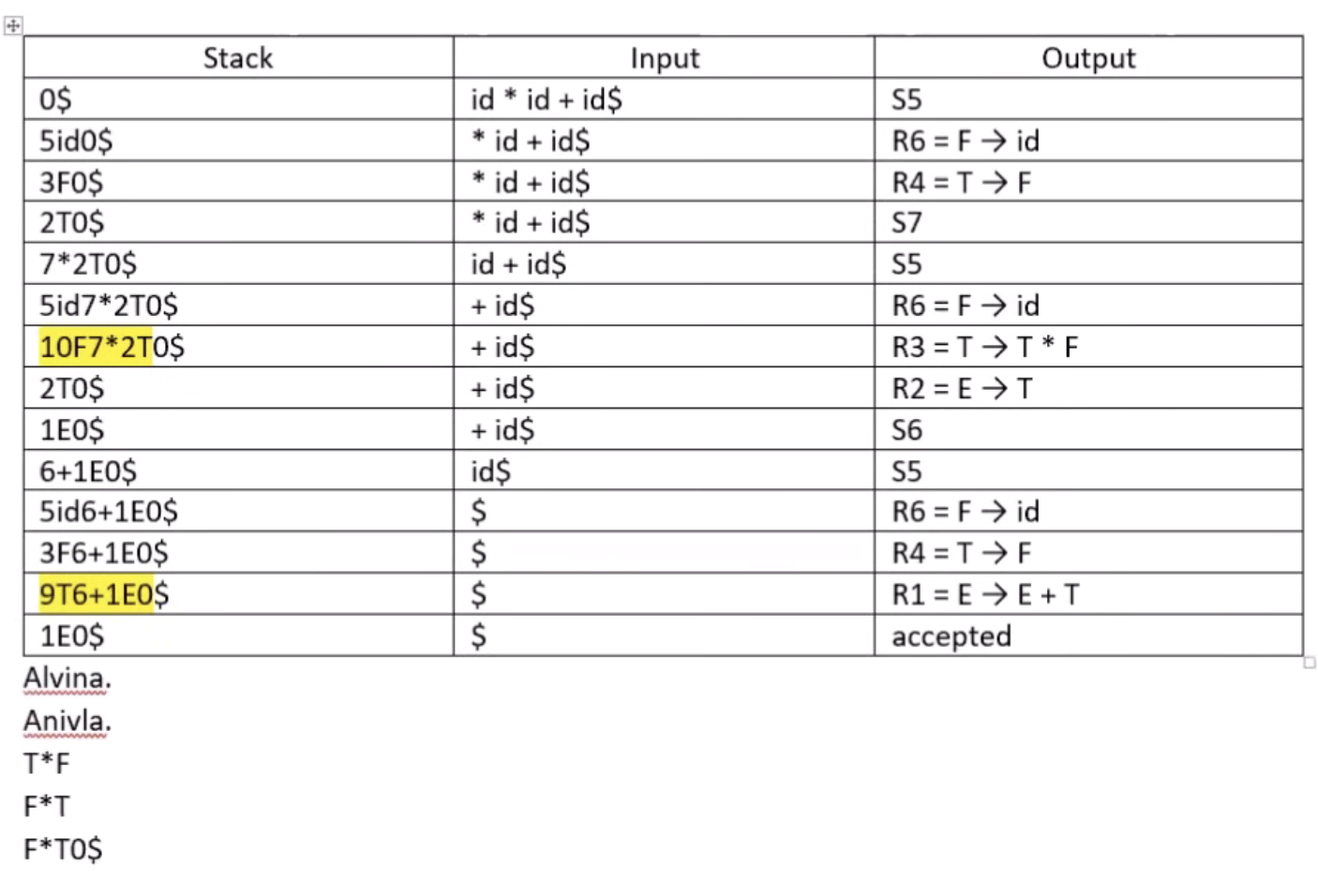Bottom Up Parsing
steps
- Perform Go To operationGo To operationSteps: 1. Make sure that one grammar has only 1 production result by removing the OR (essentially splitting the grammar) 1. Add augmented grammar (added grammar than can result a start symbol) 1. Add numbers to each grammar except augmented grammar 1. Add . at the front of each production result (used for kernel method) 1. Use the kernel method starting from the top most grammar 1. Group the grammars 1. Input the thing after the . to each grammar and group them 1. If the result has a .
- Find FollowFollowcheat: terminal or symbol after the variable Algorithm 1. If S is the start symbol, ex: S -> Ab | c, then $ is the Follow value of S 1. If A -> αBβ, then all First of β is the Follow of B except ε 1. a. A -> αB, then all Follow of *A* is the Follow of B 1. b. A -> αBβ and First of β is ε, then all Follow of *A* is the Follow of B Special case If A -> α, i.e production result contains only 1 variable, add ε in front of the variable to conform to rule 3.a. A -> α\*B You can only find the value
- Create SLR Tablerules for creating SLR TableRows are the number of groups that have ex: i0-ix Columns are all the symbols, terminals, and variables If the input is a variable, input the number of the group it results to If input is a terminal or symbol, do the same as variable but add S before the number If there is a grammar that is completed (. is at the end) and is an augmented grammar, put accepted in the dollar column If its complete and NOT augmented grammar , check i0 which line does it correspond / similar to, and use R + l
- Searchhow to do parsing search for bottom upThe first stack is the first group 0 and add $ AFTER it Input will be given and add $ AFTER it How to determine the output? * By comparing the left most of the stack and the left most of the input rules * if the output is SX then append number X as the left most of the stack, followed by the input that resulted the output and the stack from the previous operation when input is moved to the stack, it gets removed from the input * If the output is RX then replace the production result of through parsing
no need to remove Left RecursiveLeft RecursiveA -> Aα | β A -> βA' A' -> αA' | ε E -> E + T | E - T | T | C A -> A α A α β β E -> TE' | CE' E' -> +TE' | -TE' | ε A no longer exists and is now A' placed at the end of β at the top and α at the bottom min 1 α and 1 β Status: #idea Tags: compilation-techniques References
Example Alvina Aulia Bottom Up Parsing
- E -> E + T | T
- T -> T * F | F
- F -> (E) | id
Perform Go To operationGo To operationSteps: 1. Make sure that one grammar has only 1 production result by removing the OR (essentially splitting the grammar) 1. Add augmented grammar (added grammar than can result a start symbol) 1. Add numbers to each grammar except augmented grammar 1. Add . at the front of each production result (used for kernel method) 1. Use the kernel method starting from the top most grammar 1. Group the grammars 1. Input the thing after the . to each grammar and group them 1. If the result has a .:
i0:
E' -> .E
- E -> .E + T
- E -> .T
- T -> .T * F
- T -> .F
- F -> .(E)
- F -> .id
(Input E to i0)
i1:
E' -> E.
- E -> E. + T
(Input T to i0)
i2: 2. E -> T.
- T -> T. * F
(Input F to i0)
i3: 4. T -> F.

Find FollowFollowcheat: terminal or symbol after the variable Algorithm 1. If S is the start symbol, ex: S -> Ab | c, then $ is the Follow value of S 1. If A -> αBβ, then all First of β is the Follow of B except ε 1. a. A -> αB, then all Follow of *A* is the Follow of B 1. b. A -> αBβ and First of β is ε, then all Follow of *A* is the Follow of B Special case If A -> α, i.e production result contains only 1 variable, add ε in front of the variable to conform to rule 3.a. A -> α\*B You can only find the value:

Creating SLR Tablerules for creating SLR TableRows are the number of groups that have ex: i0-ix Columns are all the symbols, terminals, and variables If the input is a variable, input the number of the group it results to If input is a terminal or symbol, do the same as variable but add S before the number If there is a grammar that is completed (. is at the end) and is an augmented grammar, put accepted in the dollar column If its complete and NOT augmented grammar , check i0 which line does it correspond / similar to, and use R + l :

Searchhow to do parsing search for bottom upThe first stack is the first group 0 and add $ AFTER it Input will be given and add $ AFTER it How to determine the output? * By comparing the left most of the stack and the left most of the input rules * if the output is SX then append number X as the left most of the stack, followed by the input that resulted the output and the stack from the previous operation when input is moved to the stack, it gets removed from the input * If the output is RX then replace the production result of through parsing

Status: #idea
Tags: compilation-techniques > Final ExamCompilation Techniques NotesMid Exam
RE to DFA
RE to E-NFA to DFA
Context Free Grammar
Top down parsing
Final Exam
Bottom Up Parsing
Directed Acyclic Graph
TAC, Triples, Quadriples
Intermediate Code Generator
Code Generator
Annotated Parse Tree
Three Address Statement
resources:
https://www.youtube.com/watch?v=6yRB6dszSUo&ab_channel=HIMTIBINUS
* [x] watch all alvina aulia vids
* [x] watch responsi
(after OS)
* [ ] try example questions from kenny
* [ ] try example questions from others
* [ ] practice weak